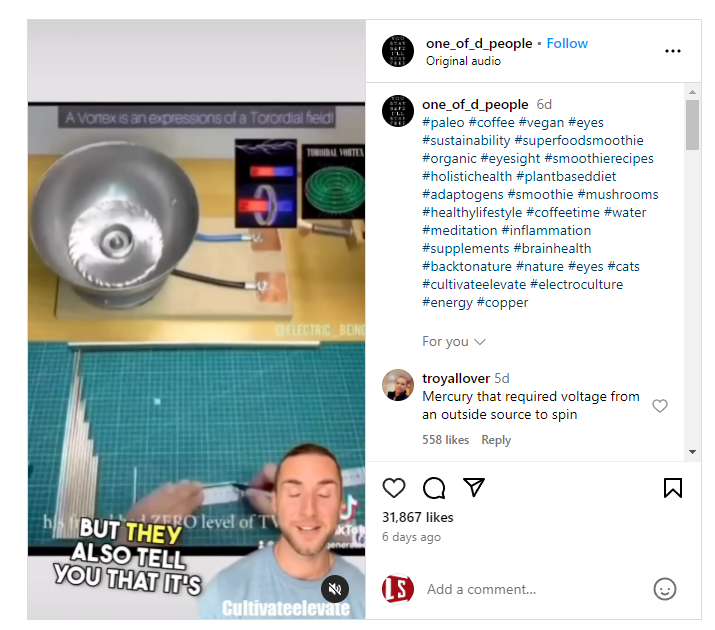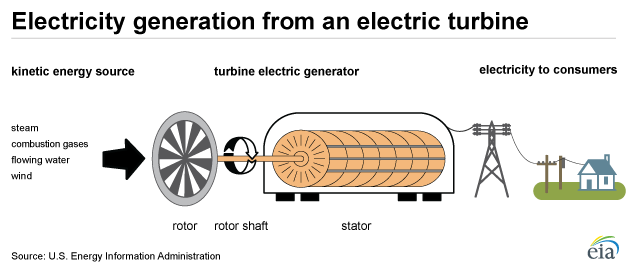
Does mercury generate "free energy" as a post on Instagram claimed? No, that's not true: Mercury is a metal that can "conduct electricity in ways similar to copper," an industrial chemist told Lead Stories and the clips shown in the video on Instagram are "all demonstrations of electromagnetism," not energy production. Furthermore, an inorganic chemist told Lead Stories that mercury is not a viable energy source and that the video in question did not offer evidence to support the claims made. Mercury "is a toxic metal," the experts added, contrary to the post's implication otherwise.
A version of the claim originated in a video shared on Instagram on February 10, 2024, (archived here). A person on the video stated, in part, that the "spinning" seen in the clip was "free energy." A caption that accompanied the post read:
#paleo #coffee #vegan #eyes #sustainability #superfoodsmoothie #organic #eyesight #smoothierecipes #holistichealth #plantbaseddiet #adaptogens #smoothie #mushrooms #healthylifestyle #coffeetime #water #meditation #inflammation #supplements #brainhealth #backtonature #nature #eyes #cats #cultivateelevate #electroculture #energy #copper
Below is how the post appeared at the time of this publication:
(Source: Instagram screenshot taken Fri Feb 16 07:55:00 UTC 2024)
Paul Frail, (archived here) an advanced senior researcher and industrial chemist, told Lead Stories in an email received on February 26, 2024, that though mercury is a metal that can "conduct electricity in ways similar to copper," it is not considered an economically viable energy source.
Mercury is much more expensive than water and other fuels. It is not as abundant and it is costly to transport due to the higher density. When mercury reacts with organic compounds it becomes very toxic to people and the environment. As a heavy metal it will bioaccumulate in the food supply. The risk to workers and the neighboring community of a power-generating plant using mercury does not seem worth the risk when the alternative working fluid is water.
Clips shown in the video above are "all demonstrations of electromagnetism," not energy production, added Frail.
Bill Carroll, (archived here) an organic chemist and professor at Indiana University, Bloomington, told Lead Stories in a phone interview on February 21, 2024, that the video in question did not offer enough evidence to support claims that mercury is "free energy." Mercury "is a toxic metal," added Carroll.
Mercury is a toxic metal incapable of generating "free energy"
Mercury is a naturally occurring chemical element found in rock in the earth's crust, according to the U.S. Environmental Protection Agency (archived here). The toxic metal has been shown to generate a small voltage (archived here) and can conduct electricity (archived here). However, neither of these conclusions indicates that mercury is a viable energy source at a larger scale, according to Carroll.
Mercury does not generate "free energy," confirmed both Frail and Carroll.
"Mercury is an element and a metal which under standard conditions is a liquid, unlike the many other metals in the periodic table. As a metal, it has the ability to conduct electricity similar to copper," explained Frail, adding that the videos used are "all demonstrations of electromagnetism."
Videos demonstrate principles of electromagnetism, not "free energy"
One of the clips shared in the video on Instagram appeared to have been taken from this video shared to YouTube on November 14, 2015 (archived here) that showed "spinning mercury with magnet and electricity." A caption that accompanied the video stated that they were "running electricity through mercury."
This a demonstration of electromagnetism, a principle introduced in the 19th century by English scientist Michael Faraday who found that a magnet moving inside a metal coil can induce an electrical current that flows through the wire, according to the American Association for the Advancement of Science (AAAS) (archived here). This principle is still used in the 21st century to generate electricity from electromagnetic generators, noted Frail.
In one of the videos used, for example, a pool of mercury begins to spin when in the presence of a magnetic field created by surrounding magnets, demonstrating an external power source.
"This demo relies on mercury's unique property of being a liquid where the conductive liquid interacts with the magnetic field... the magnet induces a current that results in the pool of mercury to spin," explained Frail.
With relation to the video shared on Instagram, Carroll generalized "free energy" into two concepts:
One is 'free energy' as an unlimited source of energy that doesn't cost anything. [The second] is a technical term called 'free energy,' particularly used to describe the concept that gives free energy, which is a physical chemistry term that talks about the amount of energy that can be released from a chemical reaction."
The video "fits the trope of a perpetual motion machine," explained Carroll. This is a theory that violates the laws of thermodynamics (archived here), a set of scientific laws that define a group of physical quantities like temperature and energy.
In short, the video implied that energy can be "created out of nothing." To work, the University of Texas at Austin (archived here) writes that "a perpetual motion machine would have to produce more energy than it takes to operate, rendering the idea impossible."
But physics simply "don't work this way," said Carroll.
Electricity is made from converted energy and most of the world's electricity is made from steam turbines, according to the U.S. Energy Information Administration (archived here):
Most U.S. and world electricity generation is from electric power plants that use a turbine to drive electricity generators. In a turbine generator, a moving fluid--water, steam, combustion gases, or air--pushes a series of blades mounted on a rotor shaft. The force of the fluid on the blades spins (rotates) the rotor shaft of a generator. The generator, in turn, converts the mechanical (kinetic) energy of the rotor to electrical energy. Different types of turbines include steam turbines, combustion (gas) turbines, hydroelectric turbines, and wind turbines.
"Mercury is not a fuel"
As indicated in the graphic above, there are "certain criteria for power generation," according to Frail. For example, the generation process needs to be scalable and transferable over large distances. Fuel sources also need to be abundant and easily transportable while processes should be efficient and nearly continuous, noted Frail.
"Today's power plants use a variety of fuels to generate steam which in turn spins a turbine that often uses electromagnetic ... coils to convert the mechanical energy to electrical energy. Solar energy uses the sun's rays and the photoelectric effect," explained Frail.
In 1942, mercury was researched and implemented (archived here) as a replacement for steam in power generation and considered in 2009 as being the working fluid for pump storage power generation (archived here). However, theories provided "free energy" and ultimately, mercury does not meet requirements needed to be an economically viable source of energy.
Additional Lead Stories fact checks of claims related to energy can be found here.
















